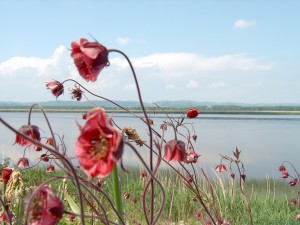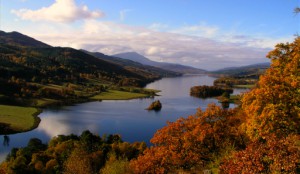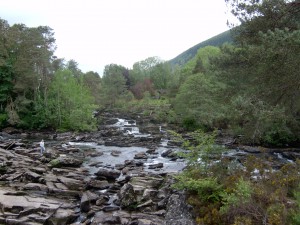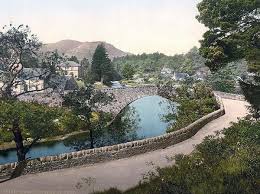Loch Tay Tour
This route contains 5hrs 12mins driving time and comes to 186 miles for the day.
This tour would take you via the scenic route via Newburgh to Perth along Loch Tummel and through Glen Lyon, Ben Lawyers National Nature Reserves than along Loch Tay to Killin and return via Comrie.
The Loch Tay Tour is intended as Half Day Tour (8am to 2 pm with a 45 min break) but can very easily be expanded to a Full Day Tour.
For art lovers we highly recommend a visit to Sun Gallery and Glen Lyon Gallery
Located on the south bank of the Firth of Tay, the royal burgh of Newburgh is an agricultural community that overlook the marshy Mugdrum Island.
To the east lies the overgrown ruins of the ancient Lindores Abbey, arguably the birthplace of Scottish whisky. The abbey overlooks the famed salmon fishing waters of the River Tay.
Perth
Perth City Centre is situated in the heart of Scotland and is a consistent winner of Beautiful Britain award. It is home to a community of eclectic retailers, atmospheric eateries, a bustling shopping centre plus many other services and cultural experiences. In Perth City Centre you can shop, eat and be entertained – it’s an ideal place for you and your family to spend the day.
Loch Tummel
Loch Tummel is a long narrow loch in Perthshire, 6 miles (9.6 km) west of Pitlochry.
The area around the River Tummel and Loch Tummel is known as Strathtummel and is one of the most beautiful parts of Perthshire’s ‘Big Tree Country’, with ever changing colours throughout the seasons and a great choice of walks, cycle routes and places to relax.
Set high above Loch Tummel is the Queens View, one of the most famous viewpoints in Scotland. The panorama west to the peak of Schiehallion and Rannoch Moor is breathtaking and the viewpoint can be accessed throughout the year, thanks to a nearby Forestry Commission car park and well maintained footpath. Visitors can also enjoy the facilities at the Queens View Visitor Centre, which is a focal point for the Tay Forest Park and has an excellent audio-visual film, tearoom, forest shop and toilets.
There are a number of Forestry Commission waymarked walking and cycling routes through Allean Forest on the hillside, just west of the Queens View. The trails provide magnificent views of Loch Tummel and the surrounding countryside, with plenty of historical and wildlife interest along the way.
To get closer to the loch, a leisurely cycle along the quiet, scenic south shore road is worthwhile.
Glen Lyon (Scottish Gaelic: Gleann Lìomhann) is a glen in the Perth and Kinross region of Scotland. It is the longest enclosed glen in Scotland and runs for 34 miles from Loch Lyon in the west to the village of Fortingall in the east. This glen was also known as “An Crom Ghleann”, (the bent glen). The land given over to the MacGregors was Scottish Gaelic: An Tòiseachd.
Quite densely inhabited from prehistoric times (as many archaeological sites attest), though its present population is of modest size, the glen has been home to many families, including MacGregors, Menzies, Stewarts, Macnaughtans, MacGibbons and the Campbells of Glen Lyon. One of this family, Robert Campbell of Glenlyon (1630–1696), led the detachment of government troops responsible for the infamous Glencoe Massacre, of the MacDonalds of Glencoe in 1691. It is not, however, the home of Clan Lyon.
James MacGregor, parish priest of Fortingall in the early 16th century, compiled the Book of the Dean of Lismore, the most important surviving collection of medieval Scottish Gaelic poetry. His Chronicle, covering local events in a mixture of Scots and Latin, is also extant, and is an important historical source for the central Highlands.
Glen Lyon, also written Glenlyon, has often been described as one of the most beautiful glens in all of Scotland. It has been the home of (among others) early Christian monks (including Adomnán [locally Eonán] (died 704), Abbot of Iona and biographer of St Columba), warriors, literary figures, explorers, castles (Meggernie Castle [still inhabited] and Carnbaan [ruined]) and arguably the best cattle in Scotland.
Its history is described in Alexander Stewart’s A Highland Parish (1928), and Duncan Campbell’s The Lairds of Glenlyon (1886).
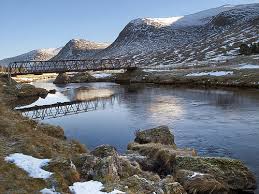
Ben Lawyers National Nature Reserve
Ben Lawers is Scotland’s tenth highest Munro and the central Highlands’ highest mountain, stretching 1,214m (3,984ft) above Loch Tay. Make it to the summit and you’ll be rewarded with magnificent views of Ben Lomond and Glencoe to the west, and the Cairngorms to the north.
It’s part of the Ben Lawers National Nature Reserve, which encompasses nine mountains within the southern slopes of the Ben Lawers and Tarmachan ranges, seven of which are Munros. The area attracts walkers and climbers of all levels, who are drawn to the varied and scenic routes available.
Ben Lawers is a hugely significant place for botanists as it is renowned for its arctic-alpine flora, many of which are rare and endangered species. The area is also home to a variety of wildlife including red deer, ptarmigan, black grouse and ravens.
Seven of the Trust’s 46 Munros are at Ben Lawers (What is a Munro?).
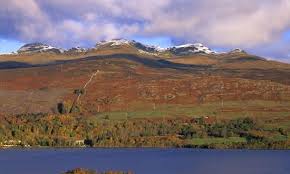 Killin
Killin
Killin lies at the centre of the area known as Breadalbane (Gaelic Bràghad Albainn meaning ‘the high ground of Scotland’) and the hills of the Tarmachan Ridge and Lawers Range can be seen clearly from the main street of the village. What Killin is most noted for, however, are the Falls of Dochart, where the River Dochart tumbles into the heart of the village beneath the Dochart Bridge. As a tourist village, it is somewhat ironic that the worse the weather, the more dramatic the main tourist attraction becomes!As the point at which two east-west glens, Dochart and Lochay, converge upon the natural transport route of Loch Tay, Killin was a natural place for a community to develop and it became home to a variety of trades such as weavers, tailors, blacksmiths and masons. The coming of the railway in 1888 changed the nature of the village, opening it up to tourism. The railway is no longer here but Killin’s economy still depends to a large part on tourism.Killin’s location, at the edge of the Ben Lawers National Nature Reserve and the Loch Lomond and Trossachs National Park, is ideal for lovers of nature and the outdoors. Wildlife abounds in the area and Ben Lawers is noted for its alpine and arctic flora.
Welcome, to our beautiful village of Comrie in Perthshire, Scotland, which lies on the banks of the River Earn nestled on the edge of the Scottish Highlands.
Comrie is in the heart of the scenic West Strathearn area of Perthshire, situated at the meeting of Glens Lednock and Artney, with the Scottish Highlands rising to the North.
The village has a wide range of local businesses, places to eat, places to stay, visitor attractions and dozens of active community organisations. We are a vibrant friendly community ready to welcome our visitors who along with our residents are encouraged to enjoy all we have to offer.
Please feel free to use the link below to submit an inquiry or call 0044 7790 021000 to discuss your requirements
